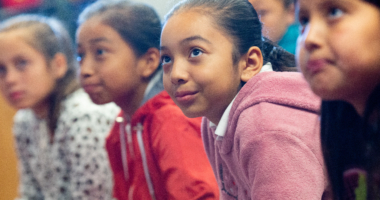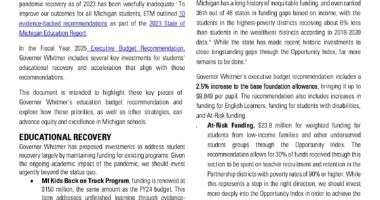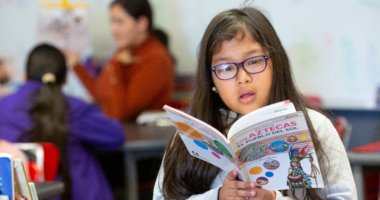Michigan Students Deserve a Fair School Funding System
Every child in Michigan is capable of high academic achievement, provided they have access to receive an excellent, affirming, joyful education. Making our statewide funding formula more equitable would be a step towards securing a future where all Michigan children have the support and resources they need to succeed.
The recent Education Trust report, Equal is Not Good Enough, An Analysis of School Funding Equity Across the U.S. and Within Each State, identifies troubling funding gaps between districts with the highest and lowest percentages of students living in poverty, Black, Latino, or Native students, and English Learners.
National findings show that districts serving the most students living in poverty receive about 5% ($800) less state and local revenue per student than districts serving the fewest students in poverty. Additionally, they find a 16% gap for districts with the most students of color and a 14% gap for districts with the most English Learners.
Michigan long has had one of the most regressive school funding systems in the nation with some of the worst resource gaps between wealthy and low-income districts. Our state ranks 36th out of 46 states in funding gaps based on income, with the students in the highest-poverty districts receiving about 6% less than students in the wealthiest districts, according to 2018-2020 data.
Our state’s inequitable funding is reflected in our poor academic performance statewide. For example, Michigan ranked 43rd in 4th grade reading and 26th in 8th grade math on the NAEP for all students in 2022. And while Michigan has had concerning achievement gaps for years, we know that the COVID-19 pandemic disproportionately harmed students from marginalized communities.
State policymakers have made small but notable strides on fair funding, including some progress for students with the greatest needs in Michigan. But far more needs to be done. Michigan’s funding formula still does not provide districts with high concentrations of poverty the appropriate funding to support their needs.
Our organization and partners are calling for a new weighted school funding system that includes greater funding for districts serving higher percentages of students living in poverty.
True weighted funding formulas include multipliers – or additional funding on top of the foundation allowance — for specific student groups with additional needs to ensure those students receive enough funding to meet their additional instructional needs.
And while Michigan’s current funding formula does apply a weighted approach for some students, the additional funding is far lower than what research recommends.
For instance, our flat 11.5% weight for students from low-income backgrounds is among the lowest in the nation compared to other states. And our additional funding for English Learners is also exceptionally low — with weights ranging from 1%-11%, based on students’ language proficiency.
Our state needs significant improvements to achieve a fair system of school funding for Michigan’s students. And research shows that money matters in education.
Michigan should follow the country’s top performing education states such as Massachusetts’ notable efforts to invest at levels that close opportunity gaps for students who have additional needs. These children include students living in concentrated poverty, rural children, English Learners and students with disabilities.
ETM’s 2023 State of Michigan Education Report recommends that Michigan should adopt a weighted funding formula, called an Opportunity Index, that accounts for students living in concentrated poverty and their additional needs. That’s contrary to Michigan’s current system, which has a flat funding weight, as noted, for students who are the most underserved. Massachusetts is phasing in a system that has weights of up to 101% for students living in the highest concentrations of poverty.
With a weighted formula, Michigan could ensure that the most under-resourced districts receive the necessary funding to provide a high-quality education to their students.
We also recommend that new investments are paired with strong new fiscal transparency and accountability systems to guarantee that dollars intended to support particular students actually reach those students. We’ll be tackling this topic more in depth in this series.
Transformative investment in a fair funding system is critical for correcting the historical under-funding of districts serving students from marginalized communities – and making sure our state is on track to be a Top 10 state for education.
_______________________________________________________
Emily Hatch is Senior Data and Policy Analyst for The Education Trust-Midwest.
This is the second in a series of blogs dedicated to exploring 10 research-based steps we can take as a state to combat educational inequities, restore unfinished learning, and set Michigan on a path to becoming a top 10 education state.









